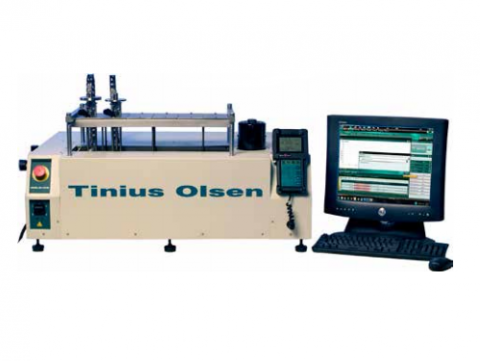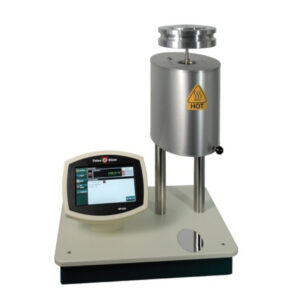Model 603 & 303 HDT
The Model 603 HDTM and the Model 303 HDTM are the latest generation of Tinius Olsen’s digitally controlled Automatic Deflection Temperature/Vicat test equipment. The 603 HDTM is capable of testing up to six different specimens simultaneously, the smaller 303 HDTM can test up to three specimens simultaneously, both with an automated testing sequence that proceeds according to user defined control and configuration parameters.
The basic Model 603 HDTM includes a six station bath, two test stations, and a handheld terminal, and up to four more stations can be added. The basic Model 303 HDTM includes a three station bath, two test stations, and a handheld terminal. Each test frame can be configured with optional accessories for either Vicat or deflection temperature testing, including 4” or 100 mm edgewise or 64 mm flatwise deflection temperature. Additionally, the machines are ready to be linked to Tinius Olsen’s Horizon software so that the PC can configure the controller, collect the test data, generate a test report, and save the results.
All test stations are pneumatically raised from the bath at the touch of a button on the handheld terminal, allowing easy placement of the test specimens. Once the specimens are loaded into the respective test positions, all stations are lowered collectively into the oil bath and the test can start.
- Description
- Additional information
Description
HIGHLIGHTS
Conforms to ISO 75, ISO 306, ASTM D648, and ASTM D1525
Fully automatic control of entire test cycle
Bath has port with an exhaust fan to remove interior oil fumes
Automatic correction for thermal expansion of test frames
Built-in heat exchanger on the 603 for rapid system cool down
Pneumatic station lift for easy specimen insertion and removal
Electronic transducers integrated into the loading rod assemblies for 0.001 mm resolution of deflection or penetration
Loading nose and rod assemblies provide 76 grams nominal load for ISO 75 ‘flatwise’ deflection temperature tests on 4 mm x 10 mm specimens at 0.45 Mpa stress
Accessories available include additional test stations, deflection temperature loading noses, Vicat loading noses and needles, weights, 64 mm span supports for ‘flatwise’ deflection temperature testing (the stations are predrilled to accept these supports)
Built-in specimen basket to catch any dislodged specimens
Air bearing-guided loading rods for virtually friction-free load application
| Specifications | Unit | 603 | 303 |
| Maximum number of stations | 6 | 3 | |
| Temperature range | ° C | 23-300 | |
| Temperature ramp | ° C | 50° or 120° per hou | |
| Temperature display resolution | ° C | 0.1 | |
| Temperature sensor | Platinum RTD located adjacent to the load application point at each station | ||
| Deflection/penetration measurement | LVDT | ||
| Deflection/penetration display resolution | mm | 0.001 | |
| Cooldown rate | Max. of 20o above cooling water temp. in 20 minutes | Max. of 20o above cooling water temp. in 30 minutes | |
| Temperature safety limit | Independent dual systems using thermostatic switch in bath and keypad selectable software limiting | ||
| 603 | 303 | |
| Dimensions (WxDxH) | 1067 x 762 x 572 mm | 813 x 635 x 585 mm |
| 42 x 30 x 22.5 in | 32 x 25 x 23 in | |
| Weight | 132 kg | 87 kg |
| 290 lb | 190 lb | |
| Heat transfer medium | 18 liters (4.8 US gallons) min | 11 liters (2.9 US gallons) |
| Water | Water supply for cooldown | |
| Clean air | Dry air filtered to 50 microns at 40psi (2.7 bar) min | |
| Power | 220 +/- 10%, 50/60Hz, 1 phase, 4.5kW | |
Updating…
Updating…
Horizon Software
Computer assisted data acquisition and machine control system which can be supplied with most Tinius Olsen testing equipment. The Horizon software package allows data to be collected, analyzed, graphed (where appropriate), and stored. If the testing machine allows, it can also provide control over testing operations.
Horizon has a comprehensive selection of pre-defined testing programs which includes powerful analysis of testing data, complex control, and sophisticated reporting. These programs can be modified and further enhanced to fit a customer’s particular requirements. The testing data collected by these programs may be exported to an outside source then later transferred to other data analysis systems. The Horizon databases may also be configured to be shared across several computers on a company’s network thereby allowing the testing programs and testing data to be utilized by multiple systems.
Using Horizon will make easy work of your materials testing, whether it’s designed for the demanding rigors of R&D or the charting and analysis functions of QC testing.
Key Features Overview
| Advanced Machine Segment Control |
| Customizable Report Layout |
| Data Archiving and Backup |
| Data Exporting (Results/Limits/Statistics/Points) |
| Data Importing (Result Entries/Limits) |
| Data Stored with SQL Server Express |
| Formula Generation |
| Library of Pre-Defined Testing Programs |
| Method/Output Editor |
| Multiple Graphs/Reports for Output |
| Multiple Machine Controlled by one Horizon |
| Multiple Users |
| Networking Databases |
| Report Consolidation |
| RS232 Device Communication |
| Security Lockout Capability |
| Touchscreen Capability |
| Video Extensometer Capability |
Test & Recall
The testing area allows for the viewing of live data from the machine while the test is being performed. Multiple tabs showcase the recalling of previous testing data as well as each testing machine connected to the software. Once a testing tab is created, it never has to be destroyed. When a new testing program needs to be run, simply change the Tab Options and load a new program. Each testing tab can be configured to display custom results, multiple graphs, multiple plots on a single graph, and live data (including custom formulas). Each tab may be customized to suite a user’s preferences.
Method/Output Editor
The testing program transferred from the Library may be customized for the customer in the Method and Output Editors. Create custom batch/sample identifiers for reporting and recalling purposes. Enhance the control of the machine with advanced machine segments. Automatically accept tests then print or email the report based on pre-defined limits. Customize multiple reports for various recipients. Import specimen data (such as dimensions or limits) from an outside file based on an identifier. Export results, limits, statistics, and/or curve points to an external file.
Custom Results
Methods transferred from the Library contain a number of results which have been standardized. In the Result Editor, however, custom result can be created. Such results can might be defined as entry type, a single point along a curve, a calculation between two points along a curve, a live source, or even a calculated formula. Depending upon how the result is created, it can be added to a testing panel to be viewed during the test or added to a report.
Library of Methods
A searchable database containing a variety of pre-defined testing routines. These methods are based on Standards from ASTM, ISO, EN, BS, DIN and many more. These routines include testing in tension, compression, flexure, torsion, melt index, heat distortion, hardness, impact, and more. Each method may be transferred into the user’s main database and customized with their own identifiers, units, report layouts, etc. With each new version update of Horizon, more and more routines are added to the Library.
Help Desk
Access to the tutorials which guide a user is various activities in the software.Displays details of the Software Key including items purchased. System Information displays valuable data regarding the software as well as the computer which it is installed upon. This guides the Tinius Olsen support staff when there are questions regarding system functionality. Please also note this page offers quick access to the Horizon QS program which will allow our Tinius Olsen support staff to take control of the computer when assistance is requested.
Additional information
| Manufacturer | Tinius Olsen |
|---|---|
| Origin | USA |
| Type | Manual |



